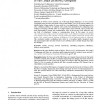Free Online Productivity Tools
i2Speak
i2Symbol
i2OCR
iTex2Img
iWeb2Print
iWeb2Shot
i2Type
iPdf2Split
iPdf2Merge
i2Bopomofo
i2Arabic
i2Style
i2Image
i2PDF
iLatex2Rtf
Sci2ools
IJAHUC
2007
2007
Configuring node status in a two-phase tightly integrated mode for wireless sensor networks
: In wireless sensor networks, one of the main design challenges is to save severely constrained energy resources and obtain a long system lifetime. Low cost of sensors enables us to initially deploy a large number of sensor nodes in a very high density. A potential approach to solve a lifetime problem is to schedule sensor nodes work alternatively by configuring some of them a low-energy, off-duty status. In a single wireless sensor network, sensors assume two main functionalities: sensing and communication. Most of the previous work addressed only one kind of redundancy: sensing or communication alone. In this paper, we prove: “the communication range is twice the sensing range” is the sufficient condition and the tight lower bound to ensure that complete coverage preservation implies connectivity among active nodes, if the original network topology (consisting of all the deployed nodes) is connected. This conclusion enables configuring node status in a two-phase tightly integrat...
| Added | 14 Dec 2010 |
| Updated | 14 Dec 2010 |
| Type | Journal |
| Year | 2007 |
| Where | IJAHUC |
| Authors | Di Tian, Zhijun Lei, Nicolas D. Georganas |
Comments (0)

